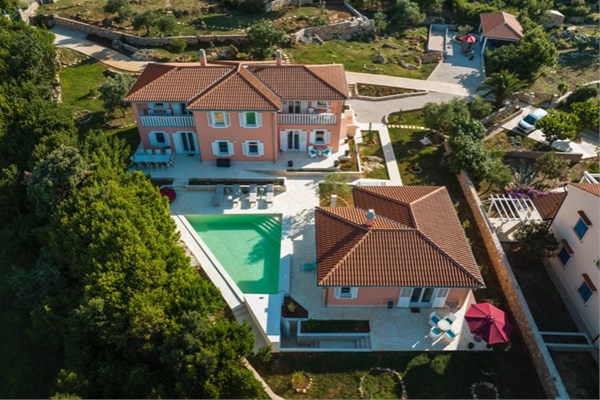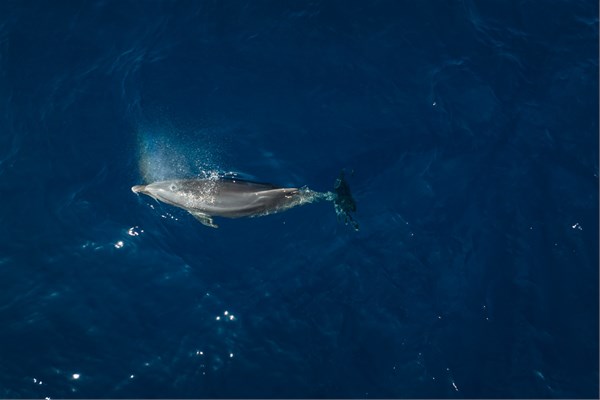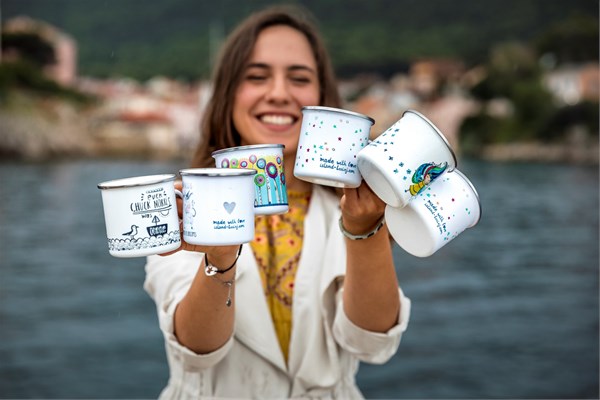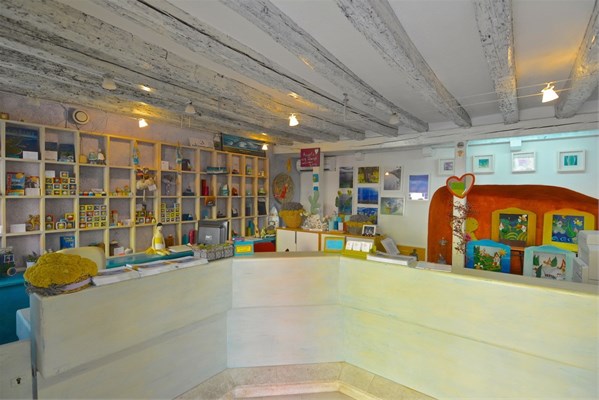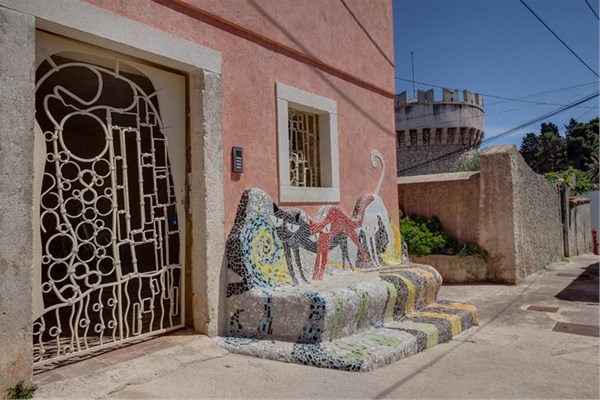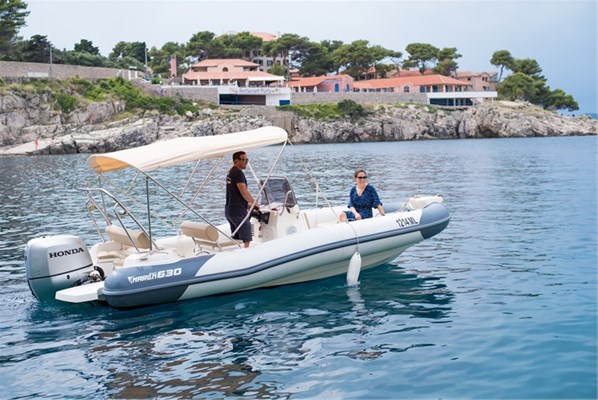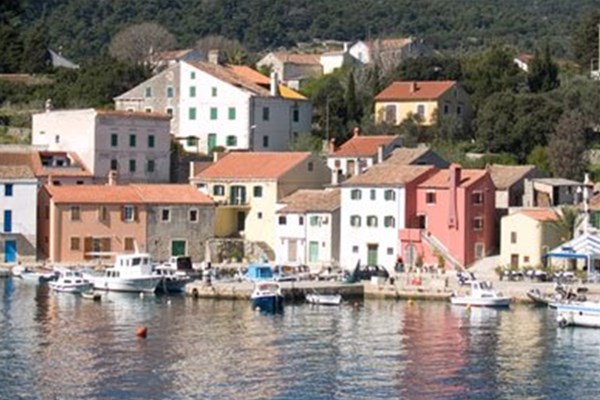Fragrant May – Sage, Fennel and Nettle
The event „Fragrances and Tastes of Lošinj“ has spread to the whole town, camps, hotels, tourist agencies, restaurants.....The fragrance network has expanded in all forms, from floral displays, potpourri, liqueurs, juices, cakes, fragrant decorations to gastro-menus where, in various ways, autochthonous island plants are used.

SAGE (lat. Salvia officinalis)
SAGE IN MY AND YOUR GARDEN
Sage is an aromatic, perennial Mediterranean subshrub that grows to 30 to 40 cm in height. The leaves are oblong and narrow, grey-green, velvety and hairy on both sides and up to 8 cm long. Two-lipped flowers form whorls on the top of the stems. It blooms from May to June and the flowers are purple-blue. It grows wild on dry and rocky terrains near the sea. It likes sunny places and is sensitive to wind and cold. In winter it freezes to the root from which dense leafy stems shoot up in spring.
NUTRITIVE VALUE
Sage contains calcium, potassium, sodium and essential oil the main components of which are cineol and camphor. The most appreciated is Dalmatian sage due to high amount of essential oil abounding in thujone (30-60%) that gives it a penetrating distinctive smell. Sage flowers are bees' favourite pasture, and sage honey is one of the most curative honeys.
IMPORTANT TO KNOW
Thujone, as the main component of sage essential oil that gives it strong distinctive smell, has an antiseptic effect, but in too large amounts it can be toxic for central nervous system. Aromatic sage bushes can be grown in pots, in warm and sheltered places. Sage is sensitive to too much humidity and frost. The plant contains the highest level of essential oil right before flowering when the tips of plants are harvested. They are then dried in a dry, dark and airy place. Dried leaves and flowers should be kept in closed containers in dark place.
INTERESTING DETAILS
An old Roman proverb says: “If death threatens, get sage from the garden. “ Charlemagne appreciated this plant so much for its curative properties that he ordered growing sage in his entire kingdom. In the Middle Ages it was highly esteemed because it was believed to be the means of prolonging life and chasing evil spirits away.
NETTLE (lat. Urtica dioica L.)
NETTLE IN MY AND YOUR GARDEN
Common nettle is one of the most famous and most spread plants. It is perennial and it can grow up to 1.5 metres in height. It has a ramified creeping underground stem and erect hairy square stem. The leaves are borne oppositely, green, heart-shaped, with serrated margins and very hairy. Nettle stings due to these hairs which, in contact with the skin, release histamine and formic acid. It prefers nutritious and humid soil. It blooms from May to September. The flowers are small and green in dense axillary inflorescences. Nettle is rich in minerals so it is good to grow it in the garden. Uncontrolled spreading is prevented by regular trimming before blooming (especially before going to seed) and controlling the new shoots from the root. Nettle manure is ideal for the protection of garden plants. A kilogram of fresh nettle should be poured over by 10 litres of boiling water and leave it for several days to ferment. For watering, the manure is used diluted. 1 litre of liquid manure is diluted with 10 litres of water.
NUTRITIVE VALUE
Since it is wide-spread and has excellent nutritive and vitamin values, it is considered to be one of the most useful, healthiest and the most accessible leafy vegetables. It is a richer source of vitamins A and C than most cultivated vegetables. It contains plenty of minerals and iron that are biodegradable so that organism can use it in full. Therefore, common nettle is ideal for the prevention of spring fatigue. It contains large amounts of potassium as well, so it is recommended to people who are using diuretics, or have problems with migraines or other spasm forms. Common nettle contains large amounts of calcium, magnesium, sodium, phosphorus, provitamin A and B2, and abounds in flavonoids, clorofile and enzymes that have a healing effect on the entire body. Young nettle leaves are a rich source of vitamin C and carotene.
COUNTERINDICATIONS: Due to its effects on the excretion of body water, persons with low blood pressure should be precautious when it comes to nettle consumption. Nettle hairs contain histamine and formic acid which in contact with skin produces a stinging sensation. Because of potential overreaction to histamine, especially careful should be persons with skin sensitive to allergies. Precautions should be taken with the consumption of fresh nettle juice. Even though nettle juice is a true vitamin and mineral “bomb”, it is necessary to boil it shortly because it can cause a strong irritation of digestive tract mucosa. Hence it should be taken watered down.
IMPORTANT TO KNOW
It is extremely important to pick nettle far away from roads because it easily absorbs lead and other harmful elements from the environment. During flowering, the whole plant is harvested and dried in airy and warm shady place in thin layers or hanging sheaves. If it is dried on paper, it should be turned round twice or thrice a day. Root is pulled out in spring or autumn. It is best to pick young leaves on the top of the plant because they have the most curative properties and the highest energy value. Intensive and strong smell of nettle in food or tea will be less noticeable if nettle is picked before flowering.
INTERESTING DETAILS
Nettle contains provitamin A which is especially useful for bad night eyesight.
FENNEL (lat. Foeniculum vulgare Mill.)
FENNEL IN MY AND YOUR GARDEN
It usually grows in the Mediterranean region on terrains in the vicinity of the sea. Fennel is biennial or perennial plant of pleasant and sweet aromatic smell. In the first year leaves grow out of the thickened root, and up to two metres high stem with leaves and flowers grows in the second year. The stem is round, blue-green and ramified in the upper part, and the leaves consist of many tiny leaves. Fennel belongs to the family of Umberlliferae (Apiceae) because the yellow flowers are borne in umbrella inflorescences. Every fruit contains about hundred seeds rich in essential oils. The seeds are little, aromatic, flat and oval, with yellow fluting and are used as a spice. It grows wild along paths and rocky places.
NUTRITIVE VALUE
This aromatic plant has been known as a vegetable, spice and medicine since the beginning of time. The stew made of fennel is considered effective with digestive difficulties. Fennel contains many diet fibres and proteins; it is an excellent source of potassium and calcium, vitamin C and manganese. From fennel seeds, the essential oil is extracted, and fruits are used for the preparation of healing tea for stomach and intestines which has a calming effect so it is appropriate for children as well.
IMPORTANT TO KNOW
For cooking, fennel with flowers on stems should not bee used, because the flowers indicate it is over-ripe. After blanching, fennel can be frozen, but will lose some of its aroma in that way.
INTERESTING DETAILS
Fennel has been grown since the ancient times, and it was especially appreciated for its healing effects on kidney and digestive diseases, eye diseases and bad eyesight. The Romans enjoyed eating fennel leaves and roots, and they used its seeds in bread and salads. In the Middle Ages it was used for dispelling insects. It was believed that it scared witches away; so on the Midsummer’s Day people would put it on their front doors. They would often block keyholes with it in order to prevent evil from entering the house.

